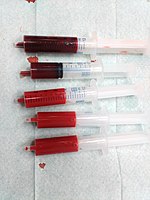
Photo from wikipedia
Significance The root cause of pathology in sickle cell disease is the polymerization of the mutant hemoglobin S upon deoxygenation in the tissues to form fibers. Both the amount of… Click to show full abstract
Significance The root cause of pathology in sickle cell disease is the polymerization of the mutant hemoglobin S upon deoxygenation in the tissues to form fibers. Both the amount of fiber at equilibrium and the kinetics of fiber formation depend on the partial pressure of oxygen. We show that control of polymerization by oxygen at equilibrium can be better explained by a recent extension of the famous two-state allosteric model of Monod, Wyman, and Changeux. Because of the unusual kinetics, polymerization is far out of equilibrium, which explains why patients with the disease manage to survive, while those with high levels of fetal hemoglobin and those with sickle trait (the heterozygous condition) have relatively benign conditions. The pathology of sickle cell disease is caused by polymerization of the abnormal hemoglobin S upon deoxygenation in the tissues to form fibers in red cells, causing them to deform and occlude the circulation. Drugs that allosterically shift the quaternary equilibrium from the polymerizing T quaternary structure to the nonpolymerizing R quaternary structure are now being developed. Here we update our understanding on the allosteric control of fiber formation at equilibrium by showing how the simplest extension of the classic quaternary two-state allosteric model of Monod, Wyman, and Changeux to include tertiary conformational changes provides a better quantitative description. We also show that if fiber formation is at equilibrium in vivo, the vast majority of cells in most tissues would contain fibers, indicating that it is unlikely that the disease would be survivable once the nonpolymerizing fetal hemoglobin has been replaced by adult hemoglobin S at about 1 y after birth. Calculations of sickling times, based on a recently discovered universal relation between the delay time prior to fiber formation and supersaturation, show that in vivo fiber formation is very far from equilibrium. Our analysis indicates that patients survive because the delay period allows the majority of cells to escape the small vessels of the tissues before fibers form. The enormous sensitivity of the duration of the delay period to intracellular hemoglobin composition also explains why sickle trait, the heterozygous condition, and the compound heterozygous condition of hemoglobin S with pancellular hereditary persistence of fetal hemoglobin are both relatively benign conditions.
Journal Title: Proceedings of the National Academy of Sciences of the United States of America
Year Published: 2020
Link to full text (if available)
Share on Social Media: Sign Up to like & get
recommendations!